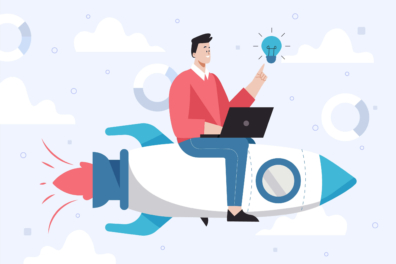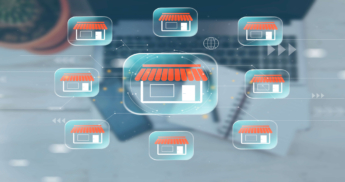Greetings! I'm Aneesh Sreedharan, CEO of 2Hats Logic Solutions. At 2Hats Logic Solutions, we are dedicated to providing technical expertise and resolving your concerns in the world of technology. Our blog page serves as a resource where we share insights and experiences, offering valuable perspectives on your queries.

Have you ever found yourself scrolling through a beautifully designed online store, adding items to your cart without a single page reload? And you wonder how they built such a smooth experience?
Or maybe you’re frustrated with your current e-commerce platform’s limitations and are looking for something more flexible?
You’re in the right place, headless commerce might be exactly what you need.
At 2Hats Logic, we’ve implemented dozens of headless commerce solutions for businesses of all sizes.
We can tell you that while it might sound technical, getting started doesn’t have to be complicated.
Headless Commerce: What is it?
Headless commerce separates your frontend (what customers see) from your backend (where all your product data, inventory, and business logic live).
This decoupling gives you incredible flexibility to create unique shopping experiences across any device or touchpoint.
Why is going headless better?
Before we dive into the steps, let’s quickly see why businesses are making the switch:

- Speed: Lightning-fast page loads without full page refreshes
- Flexibility: Use any frontend technology you want (React, Vue, etc.)
- Omnichannel: Easily connect to IoT devices, mobile apps, kiosks, or whatever comes next
- Personalization: Create highly tailored experiences for different customer segments
- Future-proof: Adopt new technologies without overhauling your entire system
5 Simple Steps to Get Started with Headless Commerce
Take a look at the steps on how to get started with headless commerce.
Step 1: Define Your Business Goals and Use Cases
Before touching any code, get crystal clear on why you’re considering headless commerce.
Are you trying to:
- Improve site performance and speed?
- Create unique shopping experiences your competitors don’t have.
- Launch an innovative mobile app that connects to your inventory?
- Prepare for future channels like voice commerce or IoT?
We recently worked with a fashion retailer who was losing mobile customers due to slow page loads. Their primary goal was speed improvement, which shaped our entire approach.
When defining your goals, involve stakeholders from marketing, sales, IT, and customer service. Each department brings valuable insights about what’s working and what’s not.
Good Example: “We need to reduce mobile bounce rates by improving page load times and creating a more app-like experience.”
Bad Example: “We want headless because everyone’s doing it.”
Step 2: Choose Your Headless Commerce Stack
A typical headless commerce stack includes
- Commerce Engine/API: The backend that handles inventory, checkout, payments, etc.
- Frontend Framework: What you’ll use to build your customer-facing interface
- CMS: For managing content separate from products
- Additional Services: Search, personalization, etc.
Let’s break down some popular options:
Commerce Engines:
Frontend Frameworks:
- Next.js (React)
- Nuxt.js (Vue)
- Gatsby
- SvelteKit
When selecting your stack, consider:
- Your team’s existing technical skills
- Budget constraints
- Specific features you need
- Long-term scalability requirements
At 2HatsLogic, we often recommend BigCommerce for mid-sized retailers looking to transition from a traditional platform, as it offers a gradual path to headless while maintaining familiar admin tools.
Need help mapping out your headless commerce strategy?
Step 3: Plan Your Data and API Strategy
The backbone of any successful headless implementation is a solid API strategy. You’ll need to map out:
- What data needs to flow between systems
- Which APIs you’ll use for different functions
- How product information will be structured
- How customer data will be managed across touchpoints
Start by creating a comprehensive data map that includes:
- Product Data: Attributes, variants, pricing, inventory
- Customer Data: Profiles, preferences, order history
- Order Data: Cart contents, payment info, fulfillment status
- Content: Marketing copy, images, videos
We once worked with a client who skipped this step and dove straight into development.
Six months later, they realized their product attribute structure couldn’t support the personalization features they wanted. Don’t make this mistake!
Pro tip:Create a visual map of all your data flows between systems. This will help identify potential bottlenecks or gaps before you start building.
Step 4: Start Small with a Proof of Concept
Now it’s time to build something! But instead of tackling your entire store, start with a focused proof of concept.
Good POC candidates include:
- A product detail page with enhanced features
- A specialized landing page for a promotion
- A mini-app for a specific product category
When building your POC:
- Focus on delivering one clear improvement over your current solution
- Set measurable goals (speed, conversion, engagement)
- Document everything for future reference
- Get feedback from actual users, not just internal teams
Remember: the goal isn’t perfection, it’s proving the concept works for your specific business case.
Step 5: Plan Your Rollout and Integration Strategy
With a successful proof of concept under your belt, it’s time to plan the broader implementation.
Consider these rollout approaches:
Phased Approach: Replace one section or feature of your store at a time
- Pros: Lower risk, easier to manage
- Cons: Longer timeline, potential for inconsistent user experience
Parallel Implementation: Build the new system alongside the old one
- Pros: Clean slate, consistent design
- Cons: Higher resource requirements, more complex launch
Hybrid Approach: Incrementally add headless features to your existing setup
- Pros: Quick wins, lower initial investment
- Cons: Technical debt, potential performance compromises
At 2HatsLogic, we typically recommend the phased approach for most businesses. It balances risk management with the ability to start seeing benefits quickly.
Don’t forget about these critical integration points:
- Inventory management
- Order processing
- Customer accounts
- Payment providers
- Shipping and fulfillment
- Analytics and tracking
Pro tip: Create a detailed migration plan for your product and customer data. This is often the most time-consuming part of going headless, but doing it right prevents major headaches later.
Common Challenges and How to Overcome Them
No major technology shift comes without challenges. Here are some we see frequently:
Challenge: Technical skill gaps
Solution: Start with training or bring in experienced partners (like 2HatsLogic) to help transfer knowledge to your team.
Challenge: Managing content across channels
Solution: Implement a strong headless CMS and create clear content workflows from day one.
Challenge: Performance optimization
Solution: Use tools like Lighthouse and WebPageTest to identify bottlenecks, and leverage modern frontend techniques like code splitting.
Challenge: Cost management
Solution: Start small and scale as you see ROI. Many headless solutions offer consumption-based pricing.
Ready to overcome these challenges with expert guidance?
Is Headless Commerce Right for You?

Headless commerce isn’t for everyone. You might be a good candidate if:
- Your current platform limits your ability to innovate
- You manage multiple sales channels
- Site performance is affecting your conversion rates
- You have unique business processes that off-the-shelf solutions can’t accommodate
- You’re planning for omnichannel growth
On the flip side, you might want to wait if:
- You have very limited technical resources
- Your basic ecommerce needs are well served by your current platform
- You’re just getting started with online selling
Conclusion
Remember, headless commerce is a journey, not a destination.
The most successful implementations start small, measure results, and scale based on proven success. At 2HatsLogic, we understand that going headless is both a technical and business transformation.
Our team brings the technical expertise to implement complex headless architectures. We’ve helped dozens of companies navigate this journey successfully. Contact us for a free strategy session to see if headless is right for you.
FAQ
What is headless commerce and why should I consider it?
Headless commerce separates your customer-facing frontend from your backend systems, giving you complete flexibility to create unique shopping experiences across any device.
What skills do my team need for a headless commerce project?
Successful headless commerce implementations typically require experience with front-end frameworks (like React or Vue), API development, and strong knowledge of the platform.
Is headless commerce more expensive than traditional ecommerce?
While headless commerce may require higher initial investment in development, it often reduces long-term costs through better performance, higher conversion rates, and greater flexibility.

Related Articles






